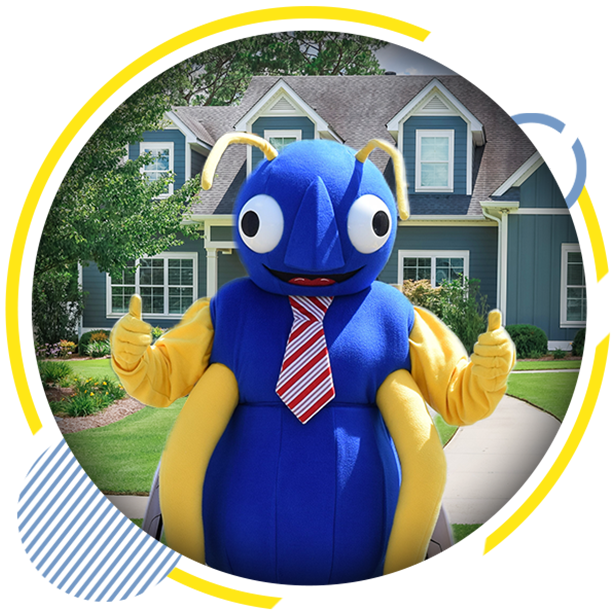
Help! Carpenter Ants Are Tearing Up My Rhode Island Home!
If you're dealing with a carpenter ant infestation in your Rhode Island home, don't panic! Read on to uncover everything you need to know about identifying, preventing, and eliminating these destructive pests. From what sets carpenter ants apart from other ant species to practical prevention tips and proven pest control methods, we've got you covered. If you're looking for reliable pest control in Rhode Island or just need some general advice on how to tackle a carpenter ant problem, read on!
How To Identify A Carpenter Ant Infestation
Carpenter ants are black ants of a fairly large size that are known for building nests in wood. They are often mistaken for termites, but carpenter ants do not eat wood like termites do. Instead, they tunnel through it to create their nests. If left uncontrolled, a carpenter ant infestation can cause significant damage to the wooden structures of your home or property. The best way to prevent this problem is to identify a carpenter ant infestation while it's still early.
Not sure if you have carpenter ants in your house? Here are some tips on how to recognize a carpenter ant infestation in your home:
- Look for sawdust: Carpenter ants create smooth tunnels in wood and push out the sawdust from the tunnels through small holes. This sawdust can be found in piles beneath or around wooden structures. Carpenter ant frass in your home, which looks just like sawdust, is something else you can look out for.
- Listen for rustling sounds: Carpenter ants tend to make rustling sounds as they move through their tunnels. If you listen carefully, you may be able to hear them.
- Check for ants: Look for large, black ants that are about ¼ to ½ inch in length. They may be seen wandering around your home or property, especially in areas with wood. Seeing live black carpenter ants in your home is a clear sign of an infestation.
- Look for damaged wood: Carpenter ants tunnel through wood to create their nests, which can weaken the structure of the wood. Look for wood that has small holes, grooves, or tunnels in it.
Inspect the exterior of your home: Carpenter ants are often found in outdoor structures such as decks, porches, and fences. Inspect these structures thoroughly for signs of an infestation. - Check for satellite nests: Carpenter ants often create satellite nests around their main nest. Satellite nests are secondary nests that are connected to the main nest of an ant colony. Satellite nests are smaller than the main nest and may be located some distance away from it. Ants use satellite nests for a variety of purposes, including storage of food, the housing of the queen, and as a location for brood rearing. Look for small piles of sawdust or ants in areas such as crawl spaces, attics, and wall voids.
These are some of the most common signs of carpenter ants in your house. If you suspect that you have a carpenter ant infestation, it is important to act quickly to prevent further damage. Contact our professional pest control company, Big Blue Bug Solutions, to assess the situation and develop a plan for elimination.
What Makes Carpenter Ants Different From Other Species?
Carpenter ants are distinct from other species in several ways. Here are some of the key characteristics that set carpenter ants apart:
- Nesting behavior
- Size
- Coloration
- Polymorphism
- Behavior
Carpenter ants are unique in their nesting behavior, as they typically excavate nests in wood. The process of nest excavation begins when a mated queen finds a suitable location for a new colony. The queen then begins to excavate a small cavity in the wood, which will serve as the nucleus of the new colony.
As the colony grows, the workers will continue to expand the nest by excavating new galleries and chambers. While carpenter ants do not consume the wood they excavate, their nesting behavior can cause damage to wooden structures over time.
Carpenter ants are also unique compared to other species due to their size. These pests are some of the largest ants in North America, with workers typically ranging in size from ¼ to ½ inch in length. The queen of a carpenter ant colony can be up to ¾ inch long. Regarding their coloration, carpenter ants are typically black but may also be red, brown, or a combination of these colors.
Like other ant species, carpenter ants show polymorphism, meaning that different members of the colony have different body shapes and sizes. However, carpenter ants have a particularly large range of body types, with some workers having large, powerful mandibles for excavating wood, while others have smaller mandibles and are better suited for tasks such as caring for the brood.
The last thing that sets carpenter ants apart from other species is their behavior. Carpenter ants are highly social insects that live in colonies headed by a queen. They exhibit a range of behaviors that are essential to the functioning of their colonies, including communication, foraging, brood care, and defense. Carpenter ants communicate with each other using chemical signals called pheromones. Unlike some other ant species, carpenter ants do not have a specialized caste of workers that performs foraging tasks. Instead, all members of the colony may participate in foraging, depending on the needs of the colony.
Carpenter ants will also care for their brood, which consists of eggs, larvae, and pupae. They keep the brood in chambers within the nest, where they are protected from predators and environmental conditions. Workers are responsible for feeding and cleaning the brood and will even move the brood to new chambers if necessary.
Carpenter ants are also capable of defending their colony from predators and other threats. When threatened, workers will swarm and bite or spray formic acid, a defensive chemical, at the intruder. In some cases, carpenter ants may also use their powerful mandibles to defend the colony.
Overall, carpenter ants are a unique type of ant that is known for their nesting behavior, size, and polymorphism. While they can be a nuisance and cause damage to wooden structures, they are also an important part of the ecosystem.
Five Carpenter Ant Prevention Tips To Implement Around Your Home
Carpenter ants are one of the most destructive pests that can invade your home. These insects can cause significant damage. If left unchecked, they can lead to costly repairs. Fortunately, there are steps you can take to deter carpenter ants from infesting your home. Here are a few prevention tips:
- Remove sources of moisture: Carpenter ants are attracted to moist areas, so eliminate any sources of moisture in and around your home. This could mean fixing leaky pipes, ensuring proper drainage, and using a dehumidifier in areas prone to moisture, such as basements and bathrooms.
- Seal entry points: Carpenter ants can enter your home through even the smallest gaps, so seal any entry points around your home. This includes sealing gaps around windows and doors, as well as any cracks in the foundation.
- Keep your home clean: Carpenter ants are attracted to food, so it's important to keep your home clean and free of food debris and crumbs. This means wiping down counters, sweeping floors, and storing food in airtight containers. Do not leave pet food bowls filled overnight, either.
- Trim trees and shrubs: Carpenter ants often make their nests in trees and shrubs, so it's crucial to keep them trimmed and away from your home. This will also help to prevent branches from touching your home, which can provide a bridge for ants to enter.
- Hire a professional pest control service: If you're having trouble with carpenter ants, it's best to call a professional pest control service. We can help you identify the source of the problem and provide effective solutions to eliminate the ants and prevent them from returning.
By implementing these five carpenter ant prevention tips, you can significantly reduce the risk of carpenter ants infesting your home. Stay vigilant and take action at the first sign of an infestation to prevent further damage to your home.

chECK oUT THE bUZZ!
Unbeatable Pest Control, Unmatched Reviews
-
"They have exceeded expectations. Highly recommend."Alley Bergemann, called before arriving on the day of the appointment, showed up on time, and took care of re-baiting the bait traps as needed. She is patient, polite and answered a few questions I had, all with a pleasant demeanor.- Jonathan P.
-
"Always been amazed by the competence and professionalism of this company."
Their man, Elijah was a gentleman and very knowledgeable professional. He took the time to carefully listen to me when I explained where the ant infestation was found. He explained clearly what he was going to do to address the issue.
- Pete M. -
"GREAT company!"The Big Blue Bug Solutions is a GREAT company with very helpful, courteous technicians. This a company that actually helps you with your problems and not try to sell you something you don't need. I am very pleased, and NO, I have no relatives that work at- Robert M.
-
"Knowledgeable, accurate and incredibly pleasant."I just cannot believe the most amazing experience customer service experience I had with Laura who could not have been more knowledgeable, accurate and incredibly pleasant. It is very rare I leave a review but this encounter deserved one!- Kimberly H.
-
"Always very polite and accommodating."We’ve been using Big Blue Bug for pest control for many years and have been very satisfied! Vince visited today for our regular check in and he is an excellent technician. Thanks, BBB!- Stacey C.
-
"Knowledgeable, respectful, courteous!"
I highly recommend Big Blue Bug Solutions - first - for their customer service. They are professional and efficient and always try to fit me in at a time that is convenient for me. Second, RODNEY IS THE BEST TECHNICIAN!!!!
- Meredith L. -
"Our first service was a great experience!"Peter called to let us know he was on his way and arrived as scheduled. He was very knowledgeable and setup a comprehensive array of traps in each target area to begin capturing the pests and put an end to our troubles.- Mike H.
-
"Personable, friendly, and knowledgeable!"Shoutout to our tech, Jeremy Cote, who has been servicing our bakery in Richmond and has helped us maintain a pest free environment. He is personable, friendly, and knowledgeable. We highly recommend big blue bug to friends, family, and customers!- Becky M.


WE'RE AVAILABLE
EVERY DAY, ALL DAY,
365 DAYS A YEAR
Say goodbye to automated systems! Our team is at your service round the clock, every single day of the year, guaranteeing a personalized and immediate response to your queries.
